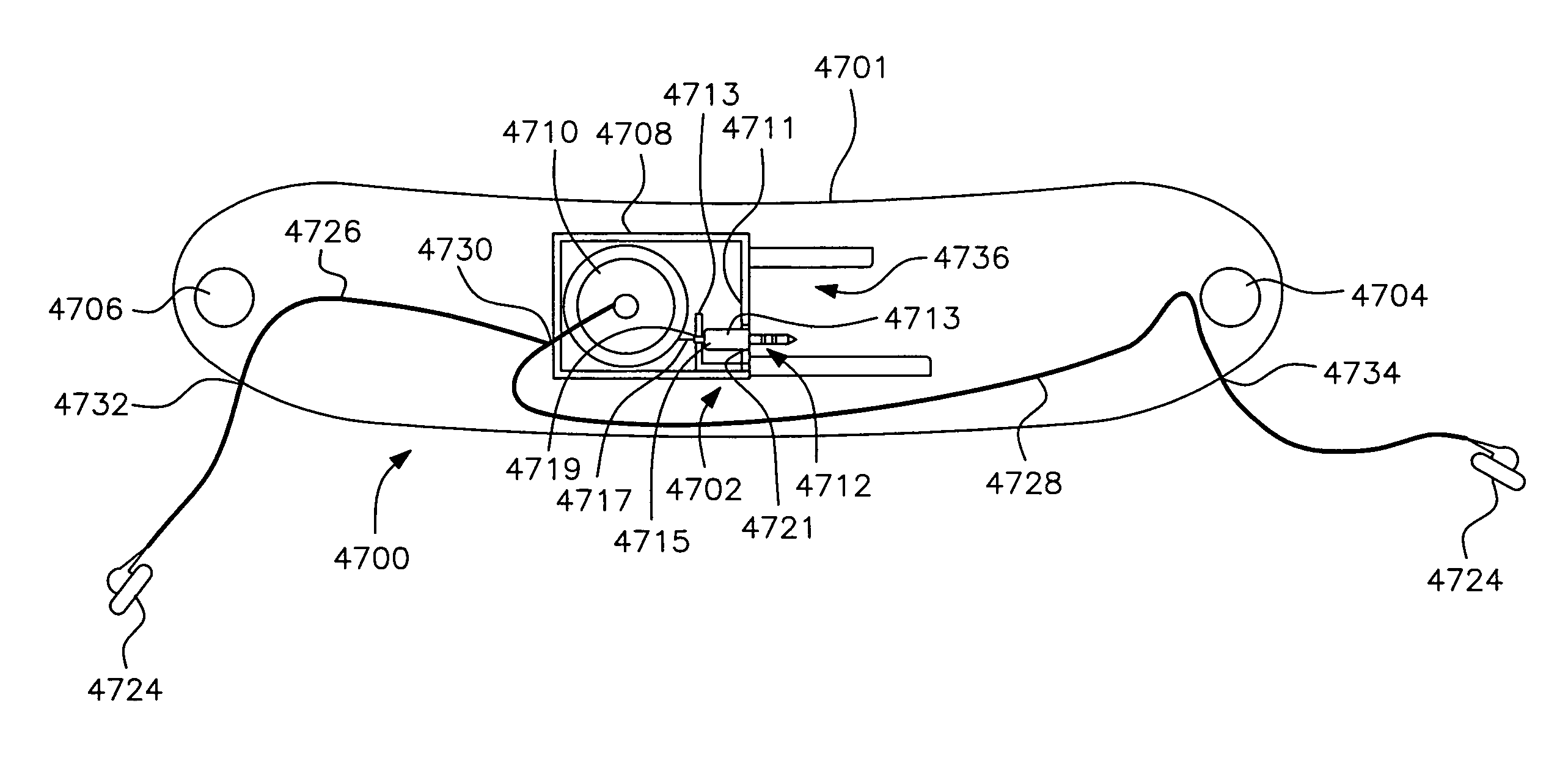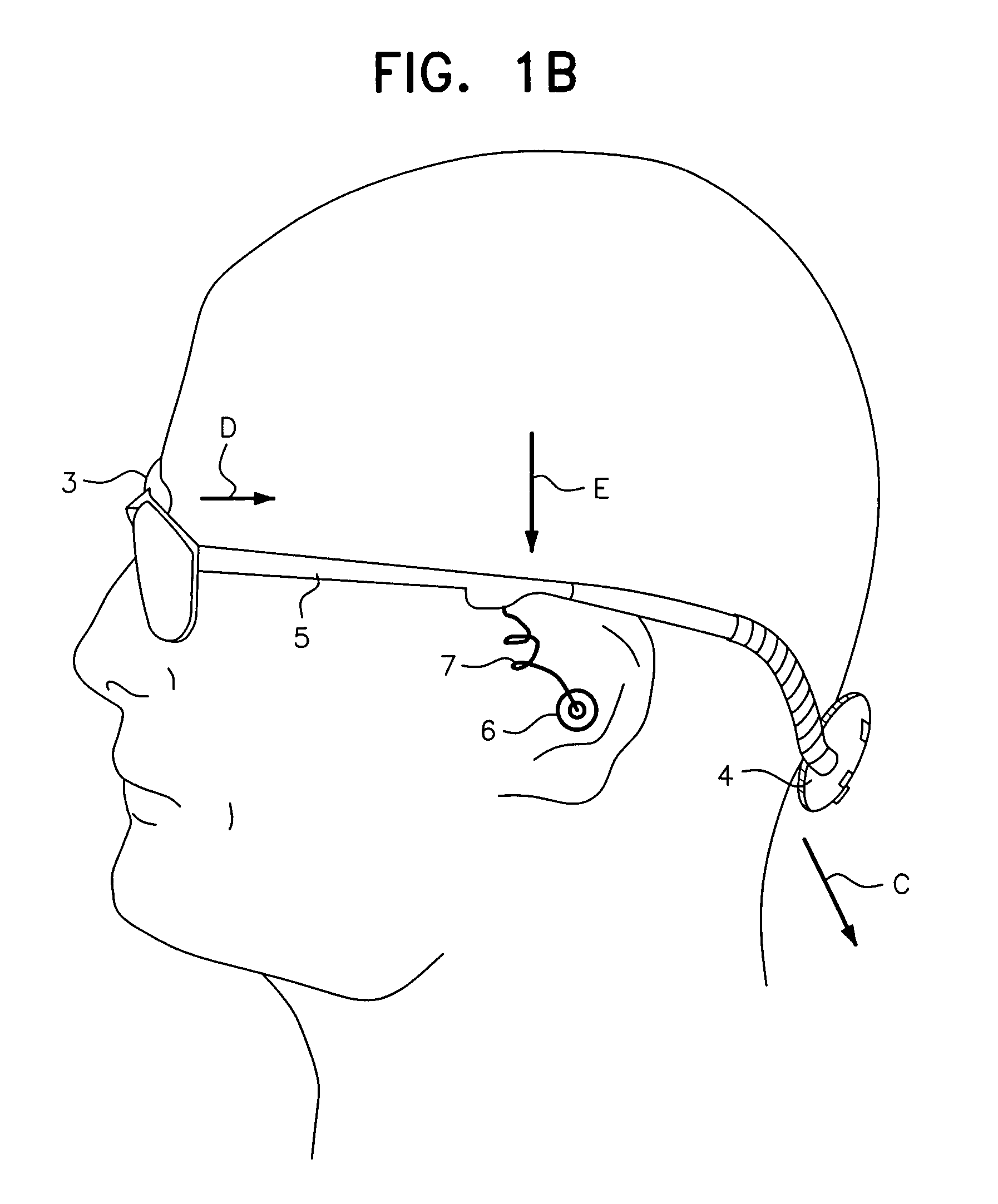However, due to a disconnection between electronic products and the biological aspects of the
human body, prior art devices have failed to provide a useful wearable electronic apparatus that adequately interact with the
human body and which fit anatomically and physiologically with the body while allowing full interaction of senses including vision.
Housing
electronics and / or power source in the frames of eyeglasses, as provided by prior art devices, creates bulky, heavy, cumbersome, and uncomfortable gear, which consistently places a
heavy weight against the users' ears which can generate discomfort.
Moreover, such heavy and awkward eyeglasses are cosmetically undesirable with buttons, ear buds, and other unattractive parts being visible at all times, taking away the elegance that can be the key feature of eyeglasses frames, and making them unsuited for use on a daily basis including at work, at school, or attending formal events.
A further problem for the prior art devices is that they rely on wires passing through the hinges at the front portion of the temples.
This makes the manufacturing process difficult and more expensive.
In addition, because the wires running through the hinges are repeatedly folded and unfolded with the temples of the glasses, the wires have a tendency to become damaged, substantially reducing the useful lifespan of the products.
However, because the electronics and
wireless transmitter are housed in the eyeglass frames, the frames are heavy and can cause discomfort over time.
Bulky, prior art eyeglass frames or head mounted gear that house electronics and / or power sources and / or and unsightly ear buds in a non-removable fashion require the user to wear the device at all times, even when the electronic functionality of the device is not being used.
Typically, however, these devices are complicated and not practical to use.
Moreover, because they are not adapted to fit well onto a human body, their weight is not well distributed, and will normally cause discomfort to the wearer, discouraging long term use of the devices.
Wearable articles of clothing (including hats) with permanent electronics embedded on them are financially unattractive, because discarding the wearable article would also require throwing away the
embedded electronics device.
Another deficiency of the prior art is a failure to disclose eyeglasses, eyeglass accessories, or wearable articles in which the user has the option to choose from a plurality of electronic functionalities using the same eyeglasses frame, eyeglass accessories, or wearable article.
The prior art also failed to disclose eyeglasses and eyeglass accessories in which the user has the option to choose from electronic devices already in possession by the user.
Another problem with electronic devices such as computers, DVD players, cellular telephones, digital music players, and electronic organizers, is that in order to be operated they require the user to hold the device or place the device on an object (such as a piece of furniture or the floor) for support.
While some cellular phones and digital music / video players have accessories that permit the user to use the device without having to hold it, using such apparatus and accessories is cumbersome, and it is necessary to carry and store the accessories until they are actually used.
Furthermore, it is easy to forget to bring the accessory, such as the ear
bud or a strap to secure a digital player to the body, when needed.
Furthermore, electronic eyeglasses and electronic eyeglass accessories of the prior art, by not having a structure designed for interchangeability, require the user to buy and carry many devices for achieving different functions.
This increases cost for the user which has to buy several electronic
eyewear accessories and the inconvenience of having to carry several electronic eyewear accessories.
This also increases cost for the manufacturer which now has to make different devices losing economies of scale, difficulties with keeping inventory of different models, and has problems with shelf space by having to display different models.
Moreover, hand-held devices are easily lost or misplaced, and unattended hand-held devices can be easily stolen.
The human body has a limited ability to support weight before pain is elicited.
If the weight pattern is not biologically fit, the stimulus of the device on the
skin will become annoying, and pain
receptor endings within the
skin will be stimulated.
In the case of wearable electronics, C fibers can be activated by excessive pressure itself and chemicals released by damaged cells, such as
crush injury, caused the weight of the device.
When the stimuli is strong enough it can produce damage and become painful.
On the other hand, significant discomfort is felt when only minor mispositioning of temples occur around the ear.
Even regular eyeglasses with conventional weight can cause discomfort around the
skin of the ear if there is not a good fit because of the larger density of pain receptors in this area.
Naturally, placing weight against the ear by temples housing electronics and / or power sources will likely elicit discomfort and pain over time.
The problem of wearable devices is further compounded by the fact that a wearable device to be truly useful has to be compact and interact with senses and biological functions of the body in a practical manner.
 Login to View More
Login to View More  Login to View More
Login to View More 


